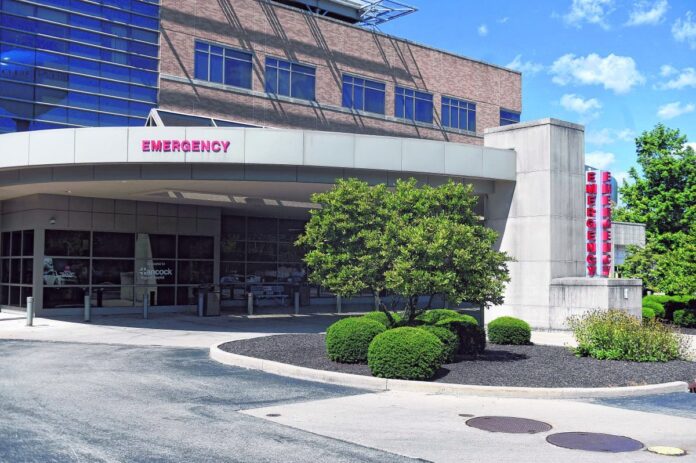
HANCOCK COUNTY — A busy day for Hancock Regional Hospital’s emergency room used to be 60 patients. Lately, that number’s grown by about a third.
And that’s not even considered a high patient count, but a typical one.
Patient volumes at the hospital’s immediate care centers are on the rise as well. Hospital officials attribute the spike to several factors, all of which stem from COVID-19. Putting off routine health care for the past year and half because of the pandemic; the novel coronavirus’s more contagious delta variant; and an increased need for COVID-19 testing are driving more patients to parts of the hospital that provide a quicker response, while also testing their ability to provide that quicker response.
Steve Long, president and CEO of the hospital and Hancock Health, said the emergency room’s increase started “almost overnight” in mid-August. The ER had a 90-patient day, another the next day, and 80 patients the day after that.
“We have been between 70 and 90 almost every day for the last few weeks,” Long said, adding that’s about a 25% to 30% jump in volume from what a high-traffic day used to be.
He thinks it’s due to a mix of reasons, one of which is people putting off routine health care throughout the past year and a half as the pandemic persisted.
“Those things have now been building in the background,” Long said, eventually worsening to the point of needing emergency care.
Dr. Taryn Papandria, medical director of Hancock Regional Hospital’s emergency department, said the ER isn’t the only area seeing more patients.

“Now we’re facing the issue of the hospital being very full as well,” she said, adding the emergency room is keeping patients for several hours at a time, taking away the ability to see new patients.
The ER keeps patients who are admitted to the hospital or require transfer to another hospital when no inpatient beds are available for them. Hancock Regional Hospital’s emergency room has 18 beds. Typically, patients can be seen quickly after arriving, and usually waits don’t last longer than 30 minutes, Papandria said. But lately, some patients have had to wait up to four hours because so many rooms are filled with other patients.
Papandria thinks part of the rise is due to COVID-19’s delta variant, which is much more contagious than previous strains of the virus. She said the vast majority of the ER’s very sick COVID-19 patients are unvaccinated.
Those fully vaccinated from COVID-19 can still become infected with the virus in what are called breakthrough cases. Papandria said many of the ER’s breakthrough cases are older people with underlying co-morbidities. Most of the younger to middle-age patients coming into the emergency room with COVID-19 have not been vaccinated, she added.
Most patients have flu-like symptoms and are able to go home with instructions to isolate, monitor their symptoms and take Tylenol to control their fever, Papandria said, adding sometimes they’re given an inhaler if they’re short of breath. The much sicker patients need treatments like oxygen, steroids, an antiviral drug called remdesivir and sometimes need to go on a ventilator. Those are the candidates for the monoclonal antibody infusion the hospital provides to COVID-19 patients.
Relaxing many of the risk-mitigation practices that had been in place earlier on in the pandemic is also likely leading to more COVID-19 patients, Papandria said.
“I think people are tired of having to be careful,” she said. “Everyone wants this to be over, so they’ve stopped wearing masks, washing hands, started congregating in big groups, which is just making it so much more transmissible, because the delta variant is so much more contagious.”
She agreed putting off routine health care is probably behind the cause as well.
“Those health conditions that got overlooked or people were too afraid to go to the doctor for are now worsened to the point that they are needing more emergency care,” she said.
Papandria noted many physicians’ practices are still only doing virtual visits, which can’t provide physical exams and can deter patients who prefer face-to-face appointments. On top of that, many doctor’s offices are backlogged as they reschedule appointments that had to be canceled when practices were limited earlier on in the pandemic.
With health care systems starting to return to as close to normal functioning as possible, Papandria encouraged patients to schedule routine visits so they don’t fall behind.
Brian Muckerheide, chief administrative officer for Hancock Physician Network, said the hospital’s immediate care locations have been seeing about twice as many patients as they were over a month ago.
The hospital has two immediate care centers — one in Greenfield and one in the Gateway facility off Mt. Comfort Road’s interchange with Interstate 70.
Visits are typically lighter this time of year before ramping up during the flu season, Muckerheide said.
“But obviously we’re in a perpetual COVID season now, it feels like,” he added.
He also thinks the novel coronavirus’s more contagious strain, along with schools being back in session, are the two biggest factors behind the rise in patients.
“The delta variant became prevalent around the same time we got back to school, so you add those two together and you end up with a significant increase in the community,” he said.
Muckerheide said the biggest issue for the immediate care locations currently is having enough COVID-19 testing supplies.
“We’re running into problems that we haven’t had since early last fall,” he said, when companies that make testing materials couldn’t keep up with demand.
Those companies got caught up last winter, and the immediate care centers had been well-stocked since then, Muckerheide said. But since this latest national surge hit, a strain on supplies has returned.
“It just makes it harder to take care of all the patients that need to be taken care of with the amount of tests we have available,” he said. “We’re scrounging anywhere we can to find additional tests.”
Muckerheide echoed Papandria’s encouragement not to delay regular health care.
“We definitely want to stress our primary care offices are safe places to go,” he said. “Don’t put off that routine care. It’s important to stay on top of that so you don’t end up in the ER. … We’re pretty full on inpatient beds too at the hospital. Those chronic conditions need to be addressed regularly and if they’re not addressed, then they become more serious and become an inpatient stay instead of just a doctor’s office visit.”
He and Papandria also encouraged those who aren’t vaccinated from COVID-19 to get the shot if they can, which would lessen their chance of getting the virus and lessen their chance of getting very sick if infected, in turn easing the strains on the hospital.
“That’s the way out of this pandemic,” Muckerheide said.
[sc:pullout-title pullout-title=”Pull Quote” ][sc:pullout-text-begin]
“I think people are tired of having to be careful. Everyone wants this to be over, so they’ve stopped wearing masks, washing hands, started congregating in big groups, which is just making it so much more transmissible, because the delta variant is so much more contagious.”
Dr. Taryn Papandria
medical director, Hancock Regional Hospital emergency department
[sc:pullout-text-end]




